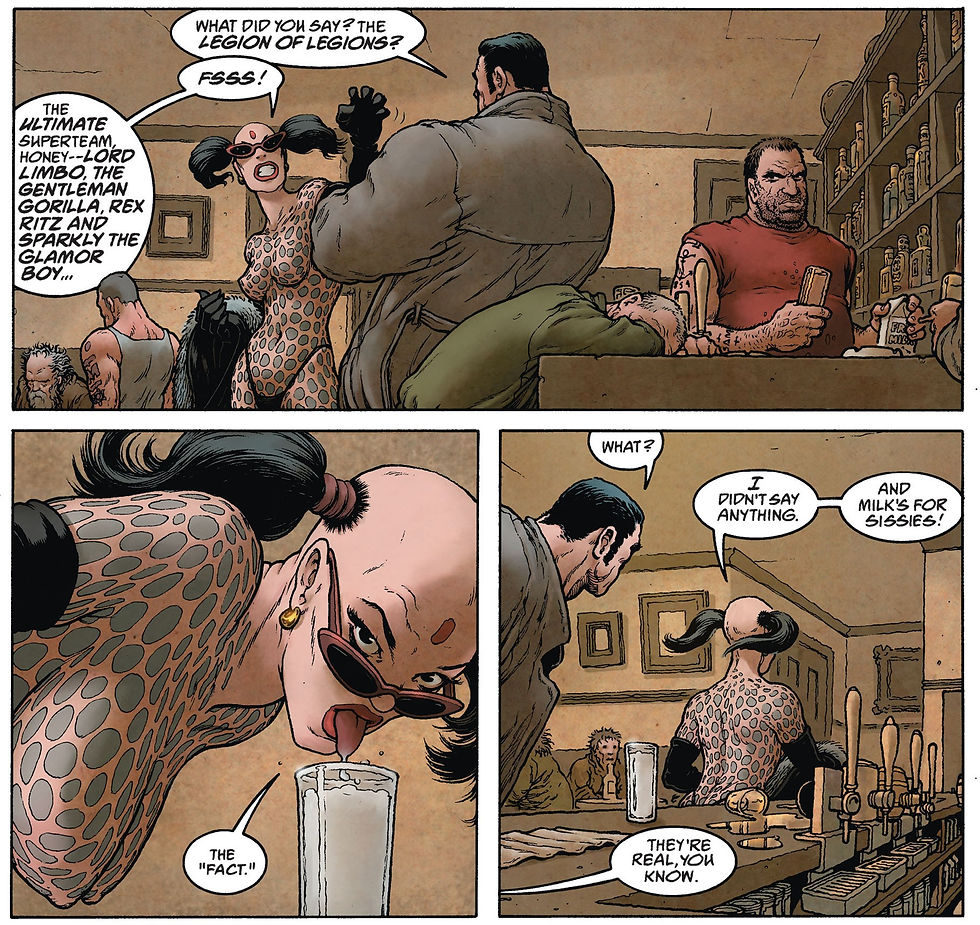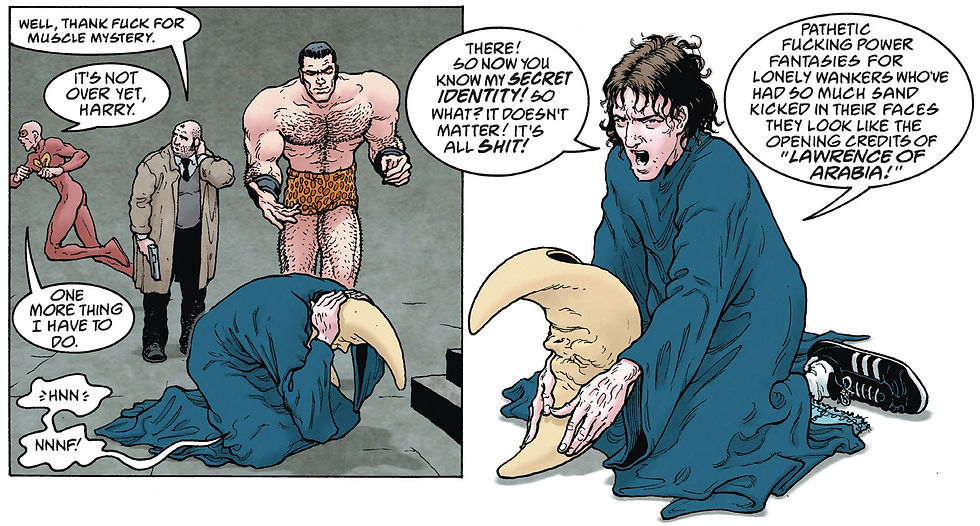POST 206 --- FLEX MENTALLO: MAN OF MUSCLE MYSTERY
- Scott Cresswell
- Feb 12, 2023
- 7 min read
If you had to rank all of Grant Morrison’s comic book runs from best to worst, you’d undoubtedly find his Doom Patrol stint from 1989 to 1993 near the top of the list. While below Animal Man and perhaps his Batman run, but far above The Invisibles and Final Crisis, Morrison’s Doom Patrol stands just above both JLA and the New 52 Action Comics title in terms of quality. Blending the original weirdness of the Doom Patrol from their first appearance in 1964 with the oddities of late-1980s comic book cultures and changes, Morrison wrote a gritty title with fantastic character to enliven and re-energise a team which had been let down desperately with flaccid tales by Paul Kupperberg. However, there was one character from Morrison’s run who – quite frankly – I didn’t like. That character was Flex Mentallo, created for Doom Patrol (vol 2) 35 by Morrison and artist Richard Case. Originally a wimpish kid named Mac, Flex Mentallo wanted muscle to impress the ladies. After reading a mysterious and mythical book on bodybuilding, he grew huge muscles and even some superhero abilities. With its colour and retro-vibes, this 1950s theme which Morrison captures is typical of the writer’s love of the silver age. However, I found the whole concept dully dated. As I said in my review of his origin issue several years ago, Flex Mentallo is “just annoying.” Will Morrison change my mind with these four issues?

Flex Mentallo 1-4 was published from June to September 1996. Written by Grant Morrison with art by Frank Quitely, this story is actually the first work in which the Morrison-Quitely duo worked together – they would later collaborate on We3, the New X-Men, and Batman and Robin. I’ve read the miniseries in their original issues.
Aside from Flex Mentallo’s origin, what else do you need to know about the character before reading this? To be honest, nothing really. Hell, I didn’t even remember his origin when I began reading this miniseries. There really isn’t any mention of substance to Morrison’s core Doom Patrol run – after all, there was a three-year gap between Doom Patrol (vol 2) 63 and Flex Mentallo 1. During this period of Morrison’s life, he was writing his famed Invisibles title, a run which is well-received if you’re into stories that make little or no sense. Regardless of my opinions on that run, the point here is that Morrison might have been taking some magic mushrooms (other drugs are available) at the time. I guess that provides some explanation to why Flex Mentallo also struggles to make sense.
With a flashy and retro-themed cover to the first issue, it begins with Flex Mentallo standing wearing just his leopard-skinned tight boxer shorts and some leather boots in a restaurant. All seems well until, suddenly, a bomb! Heroically, Flex boots the bomb away from civilians only to find that it doesn’t explode at all. So far, so good. From there, literally six pages in, things begin to fall into drivel. From here on out, we’re treated (if you want to call it that) to watching the depressing, paranoid, sad, and hectic life of a guy who swears constantly. With a love of comic books and heroes from days gone past, his relevance in the story isn’t revealed until much later on. But his name is Wally Sage, the same character who Flex Mentallo saved in his Doom Patrol story. Meanwhile however, Morrison continues to write the Flex Mentallo side of the story in a way which actually makes some sense. Going to the police, Flex Mentallo reports this bomb attack and learns about Faculty X, a group of crazed villains terrorising the city with bizarre gags. One of the left-behind gags is a piece of paper relating to a foe named The Fact. With a Riddler-like quirk, the Fact is written for most of the story to be the main villain. Although rarely seen, this mysterious villain with a bizarre character is genuinely interesting. The plotting may appear to be (for now) your average detective story, but the unique characters and the build up of a half-decent mystery is actually good stuff. For much of the remainder of issue one, Flex wanders around waiting for the Fact to show himself. Meanwhile, Sage grows suicidal and begins to take some drugs (here we go!), and it’s shown that Sage has the power to bring anything to life through drawings. When an angle like this is written for the story, I feel disappointed. Morrison’s ending to his Animal Man was fantastic because it came out of the blue. But on several occasions afterwards, Morrison has latched onto that “breaking the fourth wall” theme and by this point, it feels tired. Regardless, I suppose issue one ends pretty well – another bomb is located and this time, Flex finds that it is a real bomb. After the destruction, Flex finds a clue and believes that his quest to locate the Fact is coming along nicely...
Right from the start, the second issue ups the weirdness. After taking acid and sitting in the rain, Sage rants about the past and hallucinates. From this point on, these scenes begin their invasion on the main story, with Flex Mentallo’s hunt for the Fact continually buried under piles and piles of pretentiousness. Ignoring that side of the story, which really doesn’t come to anything, Flex Mentallo heads into the subway to find a dying druggie, one who is suffering from visions of the heroes from days gone by. Before the druggie dies, we’re shown this colourful lot and they are revealed to be the Legion of Legions. Think of this group like the Justice League for Flex Mentallo’s world (created by Sage and his pencils), except even less memorable.

To me, Morrison’s weak point has always been present when he either writes team books or creates/reimagines a team. Sure, there are some exceptions to this – such as Batman International and Doom Patrol – but I found his Invisibles team far too extreme and unbelievable in its weirdness. His JLA incarnation was a muted, albeit modern, version of the original Fox team from the sixties, while his Seven Soldiers of Victory has never hugely enthused me. The Legion of Legion may have some nice costumes, but as characters they barely have any time to breathe. They are characters of the third rank in terms of importance; Flex drops into the second division with the third issue and Sage annoying ends as the most crucial part of Morrison’s work. Regardless, Flex now searches for a nearby teleporter so he can trace Faculty X and the Legion of Legions.
While a few pulses of understandable storytelling were present in issues one and two, the story simply flatlines for the following two. Sage’s drugged-up rants are more present than before, while the main story takes a bad turn. Lieutenant Harry, a character briefly seen before, becomes more important here as he begins his own investigation into Faculty X. Working with a villain known as the Hoaxer, the two work together to track down the mysterious villain behind the oncoming apocalypse, while Flex Mentallo is taken hostage by Faculty X. With the Legion of Legions still out of action at the start of the fourth issue, it is Flex Mentallo and Lieutenant Harry who reach the real villain of the story. This robbed foe with the head of a moon has disposed of the Fact, who tried to reach him first. Whatever the name of this lunar villain is, it doesn’t matter. Flex and Harry reveal the villain to be none other than Sage. This makes sense – after all, he did create Flex and all the characters here. Maybe it would have been better, or at least readable, if Sage wasn’t shown in the story until the very end. From the start, it’s shown that Sage is behind everything through his love of comic and drawings. If we were treated to at least three full issues of Flex Mentallo being all heroic in a decent plot, then maybe this miniseries would have been good, at least until Sage appeared at the end. His inclusion into the story just complicates everything. Through boringly pretentious dialogue and page layouts, Morrison extinguishes any magic and readability which Flex Mentallo may have had. Regardless, Flex Mentallo befriends Sage once again to rescue his old buddy from his path to destruction. That’s where this miniseries ends, and thank God.

The problem with Flex Mentallo isn’t so much the plot. It emerges as a standard but admittedly interesting mystery, with Flex as the detective. However, what works with this story begins to decay pretty quickly. Sage, for all of his dominance in the story, isn’t an interesting character and Morrison gives him far far too much dialogue. It’s clear that, with Sage’s knowledge of comics books, his addiction to drugs and many other things, that Morrison is super-imposing his own life onto Sage. Morrison writes so many similarities between himself and Sage to the point where it comes just irritating and adds nothing of value. As I said before, most of the characters aren’t given time to breathe, and things are heavily hindered by a woeful structure which just confuses the reader and doesn’t entice them in any way possible. In short, the story doesn’t make sense, and it fails to communicate eligibility in its story, characters and purpose. I can compare this to several other Vertigo works, but the only other Morrison one I can mention here is Kid Eternity. That story – while terrible and unreadable in its latter half – made an inch of sense by the end. I had an opinion on the characters because they featured for a long enough period of time for one to have a judgement on them. Hell, even the plot was more comprehensive there than it was here. In the rankings of the Morrison pantheon of comic book stories, this has to be near the bottom…
It's a shame that the now-legendary modern partnership of Morrison and Quitely had to begin with this mess. However, the artist does his best with what he is given. Looking slightly more ordinary than his later work, Quitely’s art is colourfully appealing. It looks interesting, his depiction of Flex Mentallo is heroic and importantly, unlike some of those who Morrison worked with on the Invisibles, Quitely is a clear storyteller. Even when the story isn’t clear, the visuals are. Sure, his style is slightly too-underdeveloped at this stage and I doubt that his lack of weirdness would be assuredly appropriate for a title like Doom Patrol, but Quitely adds something of substance to this weak miniseries.
VERDICT
Overall, Grant Morrison’s Flex Mentallo miniseries is plainly awful. Any half-decent qualities from the first issue are obliterated by the fourth due to pretentious storytelling, far too much dialogue, and characters that fail to connect. So, to answer my question from the start about whether this miniseries would change my opinion on Flex Mentallo, I would have to say no. In fact, Morrison has easily made things worse – the star character may not be as irritating here, but he inhabits a plot which is terribly convoluted and even at times dull. Despite Frank Quitely’s art, this has to stand as one of Morrison’s weakest writings ever.
Next Week: The Batman Adventures: Super Friends (The Batman Adventures 21-27). Written by Kelley Puckett and Michael Reaves with art by Mike Parobeck and Rick Burchett.




Comments